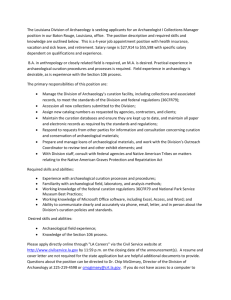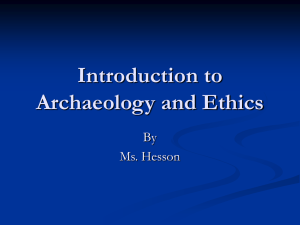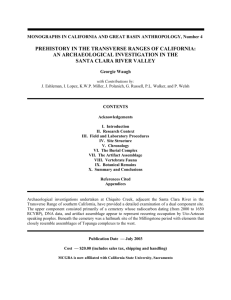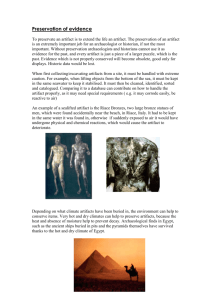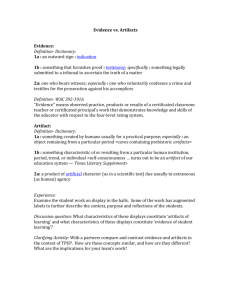The Society for Historical Archaeology Standards and Guidelines for
advertisement
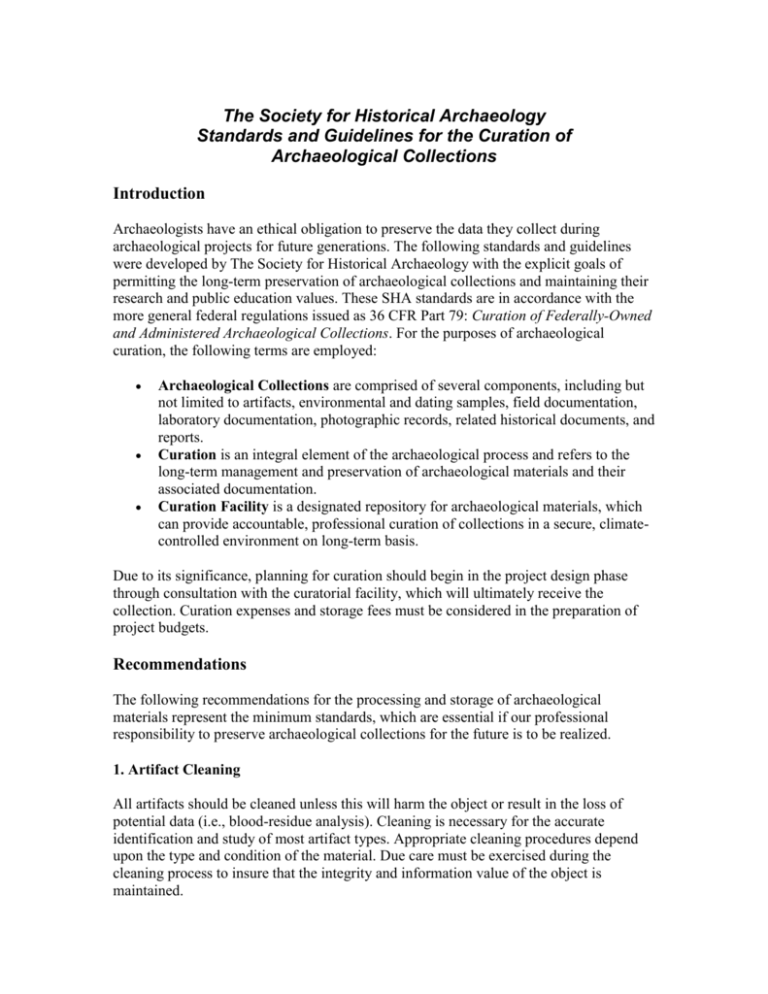
The Society for Historical Archaeology Standards and Guidelines for the Curation of Archaeological Collections Introduction Archaeologists have an ethical obligation to preserve the data they collect during archaeological projects for future generations. The following standards and guidelines were developed by The Society for Historical Archaeology with the explicit goals of permitting the long-term preservation of archaeological collections and maintaining their research and public education values. These SHA standards are in accordance with the more general federal regulations issued as 36 CFR Part 79: Curation of Federally-Owned and Administered Archaeological Collections. For the purposes of archaeological curation, the following terms are employed: Archaeological Collections are comprised of several components, including but not limited to artifacts, environmental and dating samples, field documentation, laboratory documentation, photographic records, related historical documents, and reports. Curation is an integral element of the archaeological process and refers to the long-term management and preservation of archaeological materials and their associated documentation. Curation Facility is a designated repository for archaeological materials, which can provide accountable, professional curation of collections in a secure, climatecontrolled environment on long-term basis. Due to its significance, planning for curation should begin in the project design phase through consultation with the curatorial facility, which will ultimately receive the collection. Curation expenses and storage fees must be considered in the preparation of project budgets. Recommendations The following recommendations for the processing and storage of archaeological materials represent the minimum standards, which are essential if our professional responsibility to preserve archaeological collections for the future is to be realized. 1. Artifact Cleaning All artifacts should be cleaned unless this will harm the object or result in the loss of potential data (i.e., blood-residue analysis). Cleaning is necessary for the accurate identification and study of most artifact types. Appropriate cleaning procedures depend upon the type and condition of the material. Due care must be exercised during the cleaning process to insure that the integrity and information value of the object is maintained. 2. Artifact Labeling 2a. Artifacts must be labeled in such a way that the site and intrasite provenience data are retrievable. Labeling must be done in a permanent and archivally stable manner. Where direct labeling on the object is not feasible, other archivally stable methods of permanently maintaining the relationship between an artifact and its provenience may be used (i.e., string tags with acid-free paper for beads). 2b. All diagnostic artifacts must be labeled whenever physically possible. If not appropriate, the object must be packaged in archivally stable materials, which are permanently labeled. 2c. When certain less-diagnostic artifact types occur in large quantities within a specific provenience, all specimens need not be individually labeled. Examples include but are not limited to slag, shell, fire cracked rocks, flakes, window glass, brick, mortar, plaster, and coal (exceptions should include unusual specimens or those of particular research potential). These artifacts may be grouped by material type and placed in a resealable plastic bag with the exterior permanently labeled. In the bag with less diagnostic artifacts, a Mylar or an acid-free paper slip labeled with the provenience information must be included. Other material classes not appropriate for individual labeling (i.e., floral remains, soil samples) should be stored in suitable labeled containers with a labeled Mylar strip placed inside. 2d. All faunal material, which can be physically labeled, should be labeled. Bones too small for individual marking should be placed in a labeled, resealable plastic bag. It is recommended that bones within a provenience unit be bagged separately by zoological class to prevent or reduce the crushing of fragile remains. 2e. An explanation of the label information, including locational data about the excavation units, must be submitted with the collection. It is suggested that one copy be stored with the site artifacts and one with the documentation. 3. Storage 3a. The most suitable artifact storage container currently available is the polyethylene, zip-lock-type plastic bag. Unless the curation facility requires a different container, these should be used. Paper bags and polyethylene bags of less than 2 mm thickness are not acceptable for permanent curation. Exceptionally large or unusually shaped artifacts may require different methods but should be stored using archivally stable materials. Bags should be perforated to allow air exchange and inhibit the development of unwanted microenvironments. Use of unperforated bags, however, may sometimes be appropriate for very climate-sensitive artifacts, which need special storage conditions, such as iron. 3b. It is recommended that all bags be permanently labeled with the appropriate site and provenience information. For certain fragile or sensitive materials (i.e., C14 samples or floral remains), standard-sized glass or other archivally stable containers labeled with the provenience data are recommended. 3c. Artifact storage boxes must be made of archivally stable materials and standard sized. The curation repository will determine the specific type. Consultation with the curation facility before containers are purchased is highly recommended. Artifacts must be packed in such a way as to avoid crushing or otherwise damaging them. It is also mandatory that all packing materials be archivally stable. 3d. All storage containers must be labeled with the site and provenience information. Rather than direct marking of the box, a transparent label holder affixed to the container is suggested. Listing the contents of the box may be appropriate. 3e. If storage is to be by provenience unit, certain artifact classes (i.e., ceramic vessels, bottles) should be retained in their analytic categories. They should not be disassembled nor the sherds returned to their original provenience for storage. Notation should be made in the provenience-unit documentation that these artifacts are stored elsewhere. 3f. All slides, black-and-white negatives, and prints are to be stored in archivally stable materials. 4. Documentation Records, notes, reports, catalogs, related historical documents, and photographs are integral components of an archaeological collection. They must be submitted with the artifacts for permanent curation. Two copies of all records are recommended. Paper documentation should be on acid-free paper. Readable copies reproduced by a heat fusion process (e.g., photocopy) are acceptable. Documentation must include the following: Ownership document (legal title) for archaeological materials with a complete listing of all components of the collection including the number of containers, their contents and associated provenience units, and all accompanying documentation. Catalog of the artifacts by provenience unit, recognizing that there are different levels of cataloging. At a minimum, catalogs must include an identification of the object, material of manufacture, and quantification (count and/or weight). Description of the artifact according to the best current levels of professional knowledge is recommended where possible. Notation regarding artifacts stored outside of their provenience unit should be included. Copy of the final report, site location data, project scope of work, and any relevant historical documentation pertaining to the site. Statement indicating whether conservation treatment was performed, a list of those objects treated, and a complete description of the treatments used. If conservation was not complete, a list of those objects requiring immediate attention must be included. Archivally stable photocopy of all original field and laboratory documentation. Master set of permanent black-and-white photographs, negatives, color slides, and videotapes using the best current standard films and papers. Slides should be unprojected originals or copies. All photographic material should be minimally labeled with the site, provenience, and catalog number using archivally stable methods. Catalog of all photographic materials describing the images. Electronic data (i.e., tape, disks) may accompany the documentation and must be accompanied by a by a statement describing the system and software used and the content of each disk, tape, etc. Standardized methods for the storage of electronic data will likely be developed in the future. 5. Conservation 5a. All archaeological excavation carries the professional obligation to preserve the materials recovered through both proper curation and appropriate conservation treatments. Conservation of perishable material is an ethical responsibility and an essential element in the archaeological process. Project design should include a consideration of conservation needs and the funding requirements for this essential service. 5b. Conservation is especially critical for underwater sites of all kinds and can cost up to twice the expense of the fieldwork. Excavation of an underwater site must not be undertaken without conservation facilities established beforehand and adequate funding for conservation dedicated to the project. 5c. Conservation treatments must be appropriate to the artifact's material and its condition, and should reflect the best current standards in methodology and materials. All treatments must be carried out by or under the supervision of an adequately trained professional. All treatments must be fully documented. This documentation must form a part of the site's permanent archive. 5d. The decision to conserve any artifact or class of artifacts is a complex one. It may reflect, in different cases, the condition, uniqueness, research potential, or the exhibit potential of an artifact. It may also reflect the availability of long-term storage under controlled environmental conditions and the degree to which those conditions may be achieved and precisely controlled. Consultation with the curation facility regarding this subject is strongly recommended. 6. Curation Facility 6a. Repositories used for the permanent curation of archaeological collections must provide, at a minimum, (1) physical security, (2) climate control, (3) fire suppression, (4) collection monitoring, and (5) access by qualified researchers. These requirements demand adequate space and resources dedicated to the purpose of curation. Curation space within a repository must be organized to allow controlled access, efficient collection retrieval, and optimum preservation. A professional staff, safe and secure storage, effective fire protection, disaster and pest management plans are essential. Collections should be isolated from work areas and people to the extent possible. 6b. For many historic artifacts, climate control is crucial to reduce their rate of deterioration and minimize the need for conservation treatment. Relative humidity (RH) and temperature must be continually monitored and controlled to minimize harmful fluctuations. Control of light levels, especially ultraviolet (UV) radiation is also needed. Regular inspection to detect insect, rodent, or other biological problems; assess structural defects in the physical plant; and monitor the condition of the artifacts is essential. Specific guidelines for humidity, temperature, and light control are as follows: Curation Facility (cont.) Relative Humidity: Due to the extreme sensitivity of many artifacts to RH, control of RH is crucial. For most objects, RH should be kept between 40–60% with monthly fluctuations of less than 5%. Iron and some other materials require much lower RH levels for long-term preservation. Temperature: Normally, lower temperatures are better for artifact curation because chemical and biological activity increases with higher temperatures. In areas where people are present, the temperature should remain between 65º F and 70º F. For storage spaces where people are seldom present, temperatures in the 40º F to 60º F range are desirable. Temperatures in a collections area should never exceed 75º F. Abrupt changes in temperature, which put great stress on artifacts, must be prevented. Light (UV Radiation): Light levels in collections should not exceed 150 lux (15 footcandles). Control of UV radiation is necessary to protect containers and their labels from deterioration. All light sources should be filtered for UV radiation. 6c. Where possible, the repository selected for curation should be in the same state as the site or in a facility that stores materials from the same region. Preference should be given to a facility that curates other collections from the same site or site area. 7. Deaccessioning 7a. The discarding of archaeological materials by a curation facility is not recommended because discard or deaccessioning can jeopardize the ability to study the primary site data, particularly because current levels of knowledge may not adequately recognize the research value of certain artifact classes. Exceptions are live ammunition, toxic or radioactive materials, and other hazardous substances. However, deactivation of historic ammunition rather than discard is suggested to preserve this often-rare material culture. 7b. In decisions regarding any deaccessioning, materials recovered from good archaeological contexts should be given the greatest priority for retention. First, effort should be made to find a repository that will accept material to be deaccessioned. If unsuccessful, placement in a stable environmental setting, which permits later retrieval of the material, is strongly encouraged. Decisions about any deaccessioning of archeological materials should be made by or in consultation with professional archaeologists. Any deaccessioning must be fully documented, including a thorough description of the material, the procedures used for selection of the artifacts, the sampling techniques employed, and the final destination of the material. This additional documentation must be filed with the primary site documentation. Adequate samples should be retained of any material classes that are deaccessioned. Defining what is an adequate sample will vary by material and should take into account the range of variation within a particular artifact class. 8. Human Remains Archaeologists can encounter human remains during, and these materials may be curated. All human remains must be treated in a dignified manner and with respect for the deceased individuals. Due to the wide range of potential situations, specific treatment and the ultimate deposition of human remains must be handled case by case and in accordance with applicable laws and religious traditions. Printed in The Society for Historical Archaeology Newsletter (vol. 26, no. 4) December 1993. For more information contact the Chair of the SHA's Curation, Conservation, and Collections Management Committee, Robert Sonderman at Bob_Sonderman@nps.gov.

